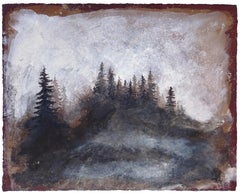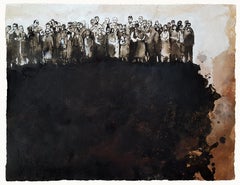Edmond Pellisson Art
to
1
Overall Width
to
Overall Height
to
1
1
1
1
1
1
1
8,780
2,809
1,653
1,313
1
Artist: Edmond Pellisson
Last View of a Great Departure - Original whandsigned watercolor - c. 1899
By Edmond Pellisson
Located in Paris, IDF
Edmond PELLISSON
Last View of a Great Departure, c. 1899
Original watercolor painting
Handsigned bottom right
On vellum 18 x 26 cm (c. 7 x 10.5in)
Excell...
Category
1890s Realist Edmond Pellisson Art
Materials
Watercolor
Related Items
"The Faraway Forest", Pigments Watercolor Acrylic Paper Drawing
By Frank Girard
Located in Clermont-Ferrand, Auvergne-Rhône-Alpes
Titled "The faraway forest", this artwork created by Frank Girard, utilizes pigments, Chinese ink, watercolors, acrylics, and colored pencils on 400g/m2 neutral white paper. It remai...
Category
2010s Realist Edmond Pellisson Art
Materials
Paper, Ink, Acrylic, Watercolor, Color Pencil, Pigment
$833 Sale Price
20% Off
H 13.39 in W 17.33 in D 0.02 in
"Persepective", Pigments Watercolor Acrylic Paper Drawing
By Frank Girard
Located in Clermont-Ferrand, Auvergne-Rhône-Alpes
Titled "Perspective", this artwork created by Frank Girard, utilizes pigments, Chinese ink, watercolors, acrylics, and colored pencils on 400g/m2 neutral white paper. It remains unfr...
Category
2010s Realist Edmond Pellisson Art
Materials
Paper, Ink, Acrylic, Watercolor, Color Pencil, Pigment
$833 Sale Price
20% Off
H 13.39 in W 17.33 in D 0.02 in
"The Cold Wind in the Pine Trees", Pigments Watercolor Acrylic Paper Drawing
By Frank Girard
Located in Clermont-Ferrand, Auvergne-Rhône-Alpes
Titled "The cold wind in the pine trees", this artwork created by Frank Girard, utilizes pigments, Chinese ink, watercolors, acrylics, and colored pencils on 400g/m2 neutral white pa...
Category
2010s Realist Edmond Pellisson Art
Materials
Paper, Ink, Acrylic, Watercolor, Color Pencil, Pigment
$833 Sale Price
20% Off
H 13.39 in W 17.33 in D 0.02 in
Watercolor of Atlantic City Beach with Lucy the Elephant By E.D. Lewis
By Edmund Darch Lewis
Located in Philadelphia, PA
Edmund Darch Lewis (American, 1835–1910)
Atlantic City Beach Scene with Elephant, 1884
Watercolor on grey paper, 8 x 18 1/2 inches(sight); Framed: 16 x 26 inches
This view of the beach near Atlantic City features Lucy the Elephant...
Category
1880s Realist Edmond Pellisson Art
Materials
Paper, Watercolor, Gouache
$3,600 Sale Price
20% Off
H 16 in W 26 in
"The Remote", Pigments Watercolor Acrylic Paper Drawing
By Frank Girard
Located in Clermont-Ferrand, Auvergne-Rhône-Alpes
Titled "The remote", this artwork created by Frank Girard, utilizes pigments, Chinese ink, watercolors, acrylics, and colored pencils on 400g/m2 neutral white paper. It remains unfra...
Category
2010s Realist Edmond Pellisson Art
Materials
Paper, Ink, Acrylic, Watercolor, Color Pencil, Pigment
$833 Sale Price
20% Off
H 17.33 in W 13.39 in D 0.02 in
"Great Pine", Tree Inhabited by Human in Nature, Drawing and Pigments on Paper
By Frank Girard
Located in Clermont-Ferrand, Auvergne-Rhône-Alpes
This drawing by Frank Girard is created with pigments, Chinese ink, watercolors, acrylic, and colored pencils on 300g/m2 neutral white paper. It is not framed.
Through drawings, the...
Category
2010s Realist Edmond Pellisson Art
Materials
Paper, Ink, Acrylic, Watercolor, Color Pencil, Pigment
$2,530
H 25.6 in W 19.69 in D 0.02 in
Hildenborough, Sevenoaks, Kent - British Watercolour by Adolphe Ragon
Located in London, GB
ADOLPHE RAGON
(1847-1924)
On the Road from Hildenborough to Sevenoaks, Kent
Signed in pencil l.r., inscribed with title l.l.
Watercolour over traces of pencil
Unframed, in conserva...
Category
Late 19th Century Realist Edmond Pellisson Art
Materials
Watercolor
$239
H 2.96 in W 5.32 in
"Elie", Trees Inhabited by Human in Nature, Pigments Ink Drawing on Paper
By Frank Girard
Located in Clermont-Ferrand, Auvergne-Rhône-Alpes
This drawing by Frank Girard is created with pigments, Chinese ink, watercolors, acrylic, and colored pencils on 300g/m2 neutral white paper. It is not framed.
Through drawings, the...
Category
2010s Realist Edmond Pellisson Art
Materials
Paper, Ink, Acrylic, Watercolor, Color Pencil, Pigment
$1,190
H 17.05 in W 11.42 in D 0.02 in
Venice - 20th Century British watercolour by Leonard Russell Squirrell
Located in London, GB
LEONARD RUSSELL SQUIRRELL, RWS
(1893-1979)
Venice
Signed and dated l.l.: L R Squirrell 1977
Watercolour heightened with white
Framed
19 by 37.5 cm., 7 ½ by 14 ¾ in.
(frame size 39...
Category
1970s Realist Edmond Pellisson Art
Materials
Watercolor
$2,465
H 7.49 in W 14.77 in
The Pool of London - 20th Century British marine watercolour by William Walcot
By William Walcot R. E. Hon. R. I. B. A.
Located in London, GB
WILLIAM WALCOT
(1874-1943)
The Pool of London
Signed and dated l.r.: W Walcot 1924
Watercolour and bodycolour over traces of pencil
Framed
40.5 by 71.5 cm., 16 by 28 ¼ in.
(frame...
Category
Early 20th Century Realist Edmond Pellisson Art
Materials
Watercolor
"Great Pine", Tree Inhabited by Human in Nature, Drawing and Pigments on Paper
By Frank Girard
Located in Clermont-Ferrand, Auvergne-Rhône-Alpes
This drawing by Frank Girard is created with pigments, Chinese ink, watercolors, acrylic, and colored pencils on 300g/m2 neutral white paper. It is not fr...
Category
2010s Realist Edmond Pellisson Art
Materials
Paper, Ink, Watercolor, Pigment, Acrylic, Color Pencil
$2,530
H 25.6 in W 19.69 in D 0.02 in
Landscape near Rye - Early 20th Cent British Watercolour by Joseph A Powell
Located in London, GB
JOSEPH ARTHUR POWELL
(1876-1961)
Oast Houses and Windmill, Rye
Signed l.l.
Watercolour
Unframed
38 by 55 cm., 15 by 21 ¾ in.
(mount size 54 by 70 cm.,...
Category
Early 20th Century Realist Edmond Pellisson Art
Materials
Watercolor
$1,301
H 14.97 in W 21.66 in
Previously Available Items
Wooden Chalet Near A Lake - Original handsigned watercolor - c. 1902
By Edmond Pellisson
Located in Paris, IDF
Edmond PELLISSON
Wooden Chalet near a Lake, c. 1902
Original watercolor painting
Handsigned bottom right
On vellum 26 x 18 cm (c. 10.5 x 7in)
Excellent condition
Category
Early 1900s Realist Edmond Pellisson Art
Materials
Watercolor
Italy : Boats Near Venice - Original handsigned watercolor - c. 1902
By Edmond Pellisson
Located in Paris, IDF
Edmond PELLISSON
Italy : Boats near Venice, c. 1902
Original watercolor painting
Handsigned bottom right
On vellum 18 x 26 cm (c. 7 x 10.5in)
There is another watercolor on the back...
Category
Early 1900s Impressionist Edmond Pellisson Art
Materials
Watercolor
White Ducks Family - Original handsigned watercolor - c. 1899
By Edmond Pellisson
Located in Paris, IDF
Edmond PELLISSON
White Ducks Family, c. 1899
Original watercolor painting
Handsigned bottom right
On vellum 18 x 26 cm (c. 7 x 10.5in)
Another pencil drawing on the back of the shee...
Category
1890s Realist Edmond Pellisson Art
Materials
Watercolor
Edmond Pellisson art for sale on 1stDibs.
Find a wide variety of authentic Edmond Pellisson art available for sale on 1stDibs. You can also browse by medium to find art by Edmond Pellisson in paint, watercolor and more. Not every interior allows for large Edmond Pellisson art, so small editions measuring 11 inches across are available. Customers who are interested in this artist might also find the work of Rosy Andreasi-Verdier, Albert Decaris, and Antoine Calbet. Edmond Pellisson art prices can differ depending upon medium, time period and other attributes. On 1stDibs, the price for these items starts at $378 and tops out at $378, while the average work can sell for $378.

